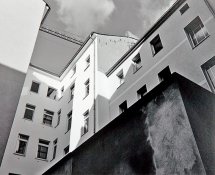Technically, pushing and pulling refer only to changes in development, although they are usually employed in conjunction with intentional under-exposure (push) or intentional over-exposure (pull)
And all they really do is change contrast and change the shape of the curve.
Their effect on the film speed is marginal - pushing increases speed a tiny bit, and pulling decreases speed a tiny bit.
There are two reasons why one would increase development.
The first - push or pull development - is employed to deal with situations that force the photographer to intentionally under-expose lr over-expose their film.
In the case of intentional under-exposure - e.g. shooting Tri-X at an EI of 1600 instead of the ISO speed of 400 - you employ increased development ("push") to improve the appearance of the lighter shadows and lower mid-tones by increasing their contrast. This tends to make the results appear nicer than regular development does. You need to understand though that this does nothing to retrieve detail that has been lost in the dark shadows due to under-exposure - they are gone for good. This also tends to decrease the quality of rendition of the highlights, and highlight rendition plays a huge roll in the satisfactory appearance of an image. So for those reasons, under-exposure plus a push development needs to be approached cautiously - it will give you less quality than a normally exposed and normally developed image.
Your Tri-X plus Rodinal examples look a lot like the results obtained from an under-exposure plus a push development - particularly the push development part.
Pull development is usually employed to deal with over-exposure that either occurs because of error or because of limitations imposed by equipment or techniques - e.g. cameras that don't offer a choice of many shutter speeds and apertures. The reduction in development helps to counteract the excess exposure in the highlights particularly, but imposes a not necessarily wanted reduction in overall contrast.
The other reason to increase development is that an increase in overall contrast - an expansion - can be used to deal with low contrast lighting and subjects. This is what Zone system people use to fit their negatives to their vision and the printing paper or process they are using. This is obviously most useful with single sheets. When you see someone referring to N+1 or N+2 development, that is what they are referring to. They will also usually decrease exposure slightly - much less than the under-exposure that usually accompanies a push development.
A similar analysis applies to a reduction in development in order to achieve a reduction in contrast - a contraction - which is used to deal with high contrast lighting and subjects. This too is obviously most useful with single sheets. When you see someone referring to N-1 or N-2 development, that is what they are referring to. They will also usually increase exposure slightly.
Here is an example of a shot from a roll that I used expansion with, due to the flat nature of the light that day:
View attachment 245994






